Study on Breaking Concrete Structures by Pulse Power Technology
Abstract
1. Introduction
2. Methodology
2.1. Mechanism Analysis of Breaking Concrete Material by Pulse Power Discharge
2.1.1. Selection of Discharge Method
2.1.2. Formation of Shock Loads
2.1.3. Simulation of Shock Wave Action
2.1.4. Simulation of a Concrete Beam Subjected to Impact Load
2.2. Test of the Concrete Beam Broken by Pulse Power Discharge
2.2.1. Specimen Design
2.2.2. Test Method
- Supercharging device: the ordinary 220 V voltage is converted into 0–100 kV high voltage through the transformer;
- Energy storage device: this consists of a number of capacitors in series and in parallel to store charge;
- Discharge device: this is composed of high and low voltage electrodes with a coaxial structure. The high voltage electrode is connected with the discharge device, and the low voltage electrode is connected with the grounding terminal.
3. Results and Discussion
3.1. Results
3.1.1. The Test Phenomenon
3.1.2. The Relation Curve between Different Parameters and Crack Width of Concrete
- Influence of hole diameter
- 2.
- Influence of discharge voltage
- 3.
- Influence of concrete strength
- 4.
- Influence of copper wire number
- 5.
- Influence of the spacing of boreholes
3.2. Expression of Breaking Effect
4. Recommendation
- Multiple discharges such as 10 discharges are used to reduce the voltage required for a single discharge;
- The discharge voltage of concrete with 20 MPa strength grade is 60 kV, and the number of copper wires is 60; the discharge voltage of concrete with 30 MPa strength grade is 80 kV, and the number of copper wires is 60; the discharge voltage of concrete with 30 MPa strength grade is 100 kV, and the number of copper wires is 60.
- The drilling of the beam is 40 mm in diameter and 300 mm in spacing.
5. Conclusions
Author Contributions
Funding
Institutional Review Board Statement
Informed Consent Statement
Data Availability Statement
Conflicts of Interest
References
- Kozhevnikov, V.Y.; Kozyrev, A.V.; Semeniuk, N.S.; Kokovin, A.O. Theory of a High-Voltage Pulse Discharge in a High-Pressure Gas: Hydrodynamic and Kinetic Approaches. Russ. Phys. J. 2018, 61, 603–610. [Google Scholar] [CrossRef]
- Han, R.; Wu, J.; Zhou, H.; Zhang, Y.; Qiu, A.; Yan, J.; Ding, W.; Li, C.; Zhang, C.; Ouyang, J. Experiments on the characteristics of underwater electrical wire explosions for reservoir stimulation. Matter Radiat. Extremes 2020, 5, 24. [Google Scholar] [CrossRef]
- Owada, S.; Suzuki, R.; Kamata, Y.; Nakamura, T. Novel Pretreatment Process of Critical Metals Bearing E-Scrap by Using Electric Pulse Disintegration. J. Sustain. Met. 2018, 4, 157–162. [Google Scholar] [CrossRef]
- Biela, J.; Marxgut, C.; Bortis, D.; Kolar, J.W. Solid state modulator for plasma channel drilling. IEEE Trans. Dielectr. Electr. Insul. 2009, 16, 1093–1099. [Google Scholar] [CrossRef]
- Wielen, K.; Pascoe, R.; Weh, A.; Wall, F.; Rollinson, G. The influence of equipment settings and rock properties on high voltage breakage. Miner. Eng. 2013, 46-47, 100–111. [Google Scholar] [CrossRef]
- Yan, H.; Zhang, J.; Zhou, N.; Chen, J. The Enhancement of Lump Coal Percentage by High-Pressure Pulsed Hydraulic Fracturing for Sustainable Development of Coal Mines. Sustainability 2019, 11, 2731. [Google Scholar] [CrossRef]
- Jahami, A.; Temsah, Y.; Khatib, J.; Baalbaki, O.; Kenai, S. The behavior of CFRP strengthened RC beams subjected to blast loading. Mag. Civ. Eng. 2021, 103, 10309. [Google Scholar] [CrossRef]
- Temsah, Y.; Jahami, A.; Aouad, C. Silos structural response to blast loading. Eng. Struct. 2021, 243, 112671. [Google Scholar] [CrossRef]
- De, S.; Ranjith, P.G.; Perera, M.S.A.; Wu, B.; Rathnaweera, T.D. A modified, hydrophobic soundless cracking demolition agent for non-explosive demolition and fracturing applications. Process Saf. Environ. Prot. 2018, 119, 1–13. [Google Scholar] [CrossRef]
- Desirée, M.; Alba-Rodríguez, A.; Alejandro Martínez-Rocamora, B.; Patricia González-Vallejo, A.; Marrero, M. Building rehabilitation versus demolition and new construction: Economic and environmental assessment. Environ. Impact Asses. Rev. 2017, 66, 115–126. [Google Scholar] [CrossRef]
- Murakami, K.; Dosho, Y.; Uemura, K.; Kimura, H. Concrete Demolition and Surface Scraping using High Voltage Pulse Discharge. J. Adv. Concr. Technol. 2018, 16, 358–367. [Google Scholar] [CrossRef]
- Yudin, A.S.; Voitenko, N.V.; Kuznetsova, N.S. Two-Section Pulse Current Generator for Concrete and Rocks Destruction by Splitting Off. IEEE Trans. Plasma Sci. 2017, 45, 3042–3045. [Google Scholar] [CrossRef]
- Wang, X.; Zhu, J. Research and Applications of High-voltage Pulse Discharge Crushing. Eur. J. Electr. Eng. 2019, 21, 157–163. [Google Scholar] [CrossRef]
- Yan, G.; Zhang, Z.; Zhang, B.; Zhu, G.; Yao, H.; Zhu, X.; Han, J.; Liu, R.; Zhao, Y. Preferential sequence crushing of copper ore based upon high-voltage pulse technology. Miner. Eng. 2019, 131, 398–406. [Google Scholar] [CrossRef]
- Kuznetsova, N.S.; Lopatin, V.V.; Yudin, A.S. Effect of Electro-Discharge Circuit Parameters on the Destructive Action of Plasma Channel in Solid Media. J. Phys. Conf. 2014, 552, 012029. [Google Scholar] [CrossRef]
- Yudin, A.S.; Kuznetsova, N.S.; Bakeev, A.; Zhgun, D.V.; Stefanov, Y.P. Destruction of reinforced concrete by electric impulse discharges: Experiment and simulation. AIP Conf. Proc. 2017, 1909, 20234. [Google Scholar] [CrossRef]
- Koji, U.; Naoyuki, S.; Shintaro, S.; Yamachi, H.; Nakamori, J. Controlled disintegration of reinforced concrete blocks based on wave and fracture dynamics. Procedia Struct. Integr. 2016, 2, 350–357. [Google Scholar] [CrossRef][Green Version]
- Lisitsyn, I.V.; Inoue, H.; Katsuki, S.; Akiyama, H.; Nishizawa, I. Drilling and Demolition of Rocks by Pulsed Power. In Proceedings of the 12th IEEE International Pulsed Power Conference, Monterey, CA, USA, 27–30 June 1999. [Google Scholar]
- Sun, X.; Ma, R.; Lv, J. Experimental Study on Crushing Rock Using High Voltage Pulse Power Technology. Chin. J. Undergr. Space Eng. 2020, 16, 1657–1664. [Google Scholar]
- Illias, H.A.; Tunio, M.A.; Mokhlis, H.; Chen, G.; Bakar, A.H.A. Experiment and modeling of void discharges within dielectric insulation material under impulse voltage. IEEE Trans. Dielectr. Electr. Insul. 2015, 22, 2252–2260. [Google Scholar] [CrossRef]
- Zuo, W.; Shi, F.; Manlapig, E. Modelling of high voltage pulse breakage of ores. Miner. Eng. 2015, 83, 168–174. [Google Scholar] [CrossRef]
- Yan, D.; Bian, D.C.; Ren, F.; Yin, Z.Q.; Zhao, J.C.; Niu, S.Q. Study on breakdown delay characteristics based on high-voltage pulse discharge in water with hydrostatic pressure. J. Power Technol. 2017, 97, 89–102. [Google Scholar]
- Yin, Z.Q.; Zhao, J.C.; Jia, S.H.; Bian, D.C.; Dong, Y. Experimental Study of Water Shock Load Characteristics Based on High-voltage Pulse Discharge. Coal Technol. 2016, 35, 182–185. [Google Scholar]
- Uenishi, K.; Yamachi, H.; Yamagami, K.; Sakamoto, R. Dynamic fragmentation of concrete using electric discharge impulses. Constr. Build. Mater. 2014, 67, 170–179. [Google Scholar] [CrossRef]
- Cho, S.H.; Cheong, S.S.; Yokota, M.; Kaneko, K. The Dynamic Fracture Process in Rocks Under High-Voltage Pulse Fragmentation. Rock Mech. Rock Eng. 2016, 49, 3841–3853. [Google Scholar] [CrossRef]
- Touya, G.; Reess, T.; Pécastaing, L.; Gibert, A.; Domens, P. Development of subsonic electrical discharges in water and measurements of the associated pressure waves. J. Phys. D Appl. Phys. 2006, 39, 5236–5244. [Google Scholar] [CrossRef]
- Catovic, A.; Kljuno, E. Comparation of Analytical Models and Review of Numerical Simulation Method for Blast Wave Overpressure Estimation after the Explosion. Adv. Sci. Technol. Eng. Syst. J. 2021, 6, 748–756. [Google Scholar] [CrossRef]
- Wang, X.; Li, N.; Du, J.; Wang, W. Concrete crushing based on the high-voltage pulse discharge technology. J. Build. Eng. 2021, 41, 102366. [Google Scholar] [CrossRef]
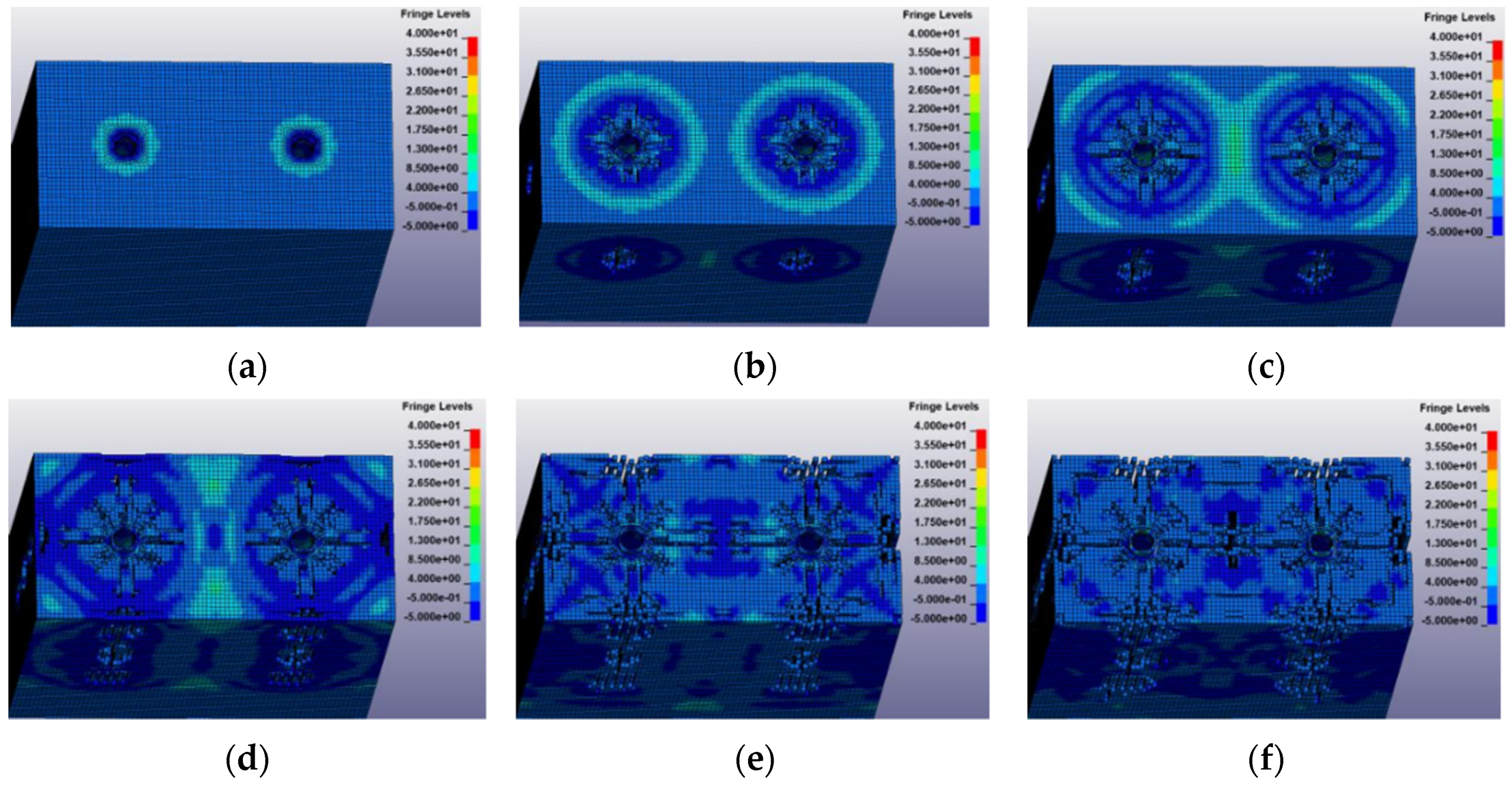



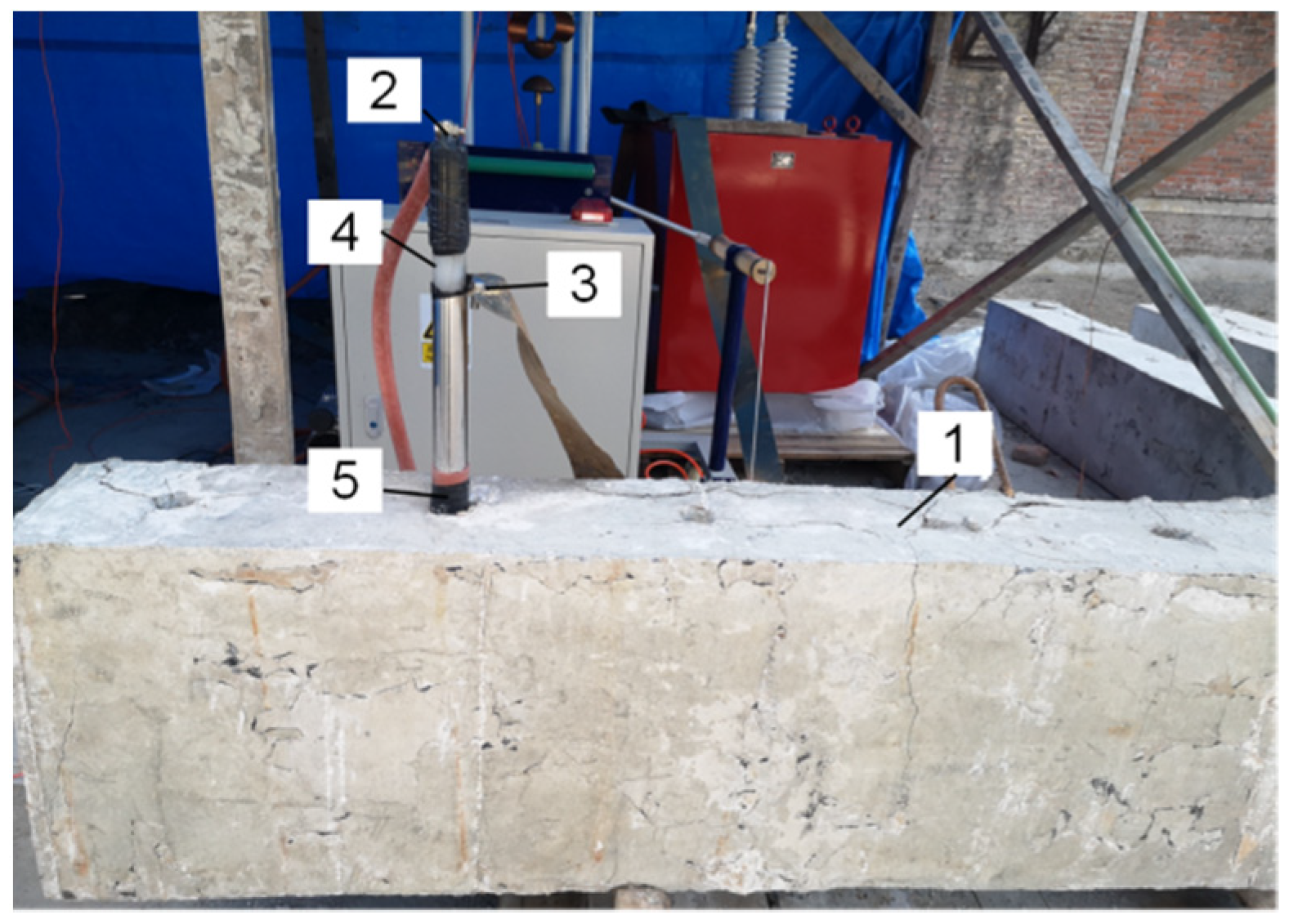
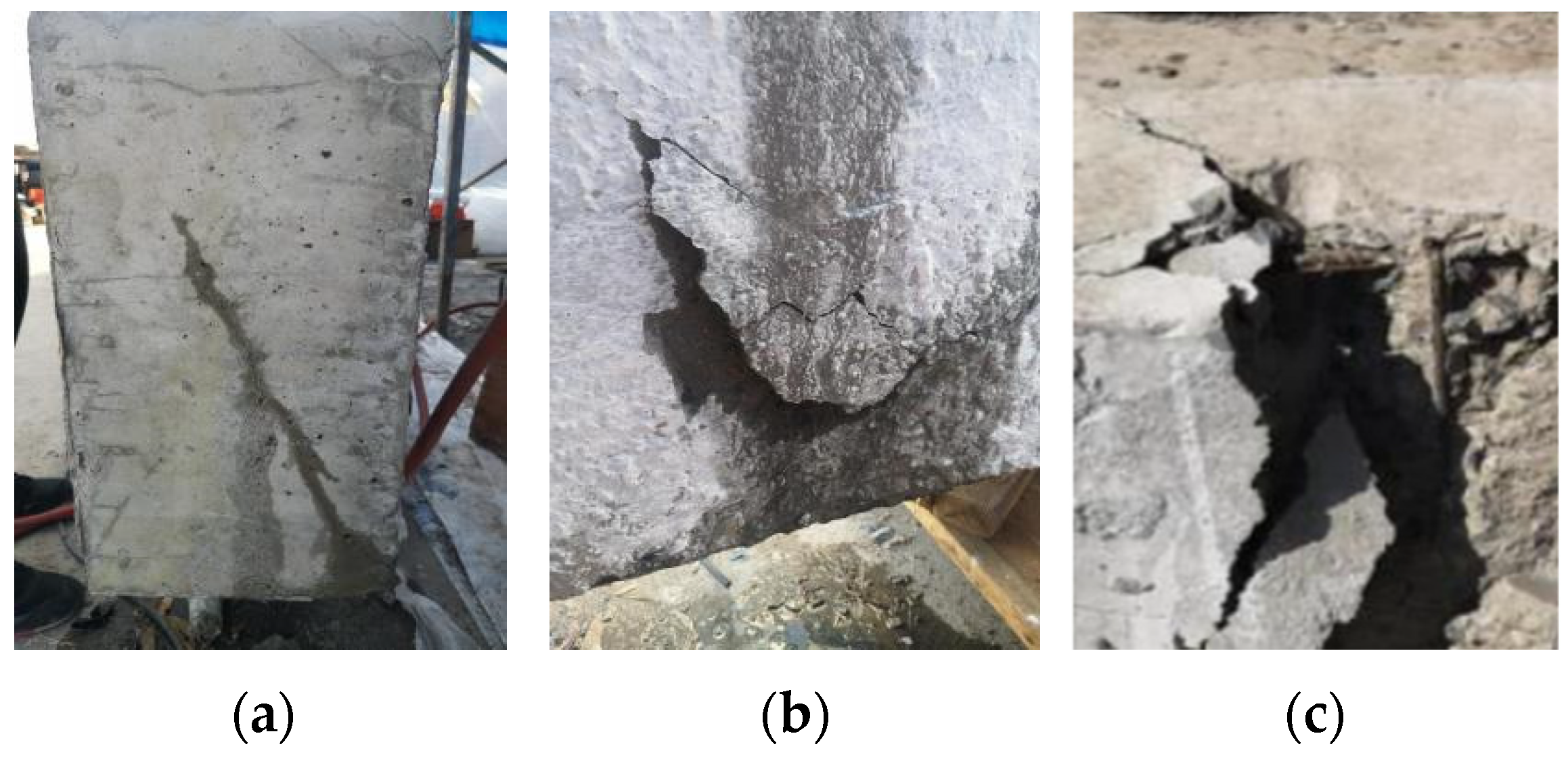

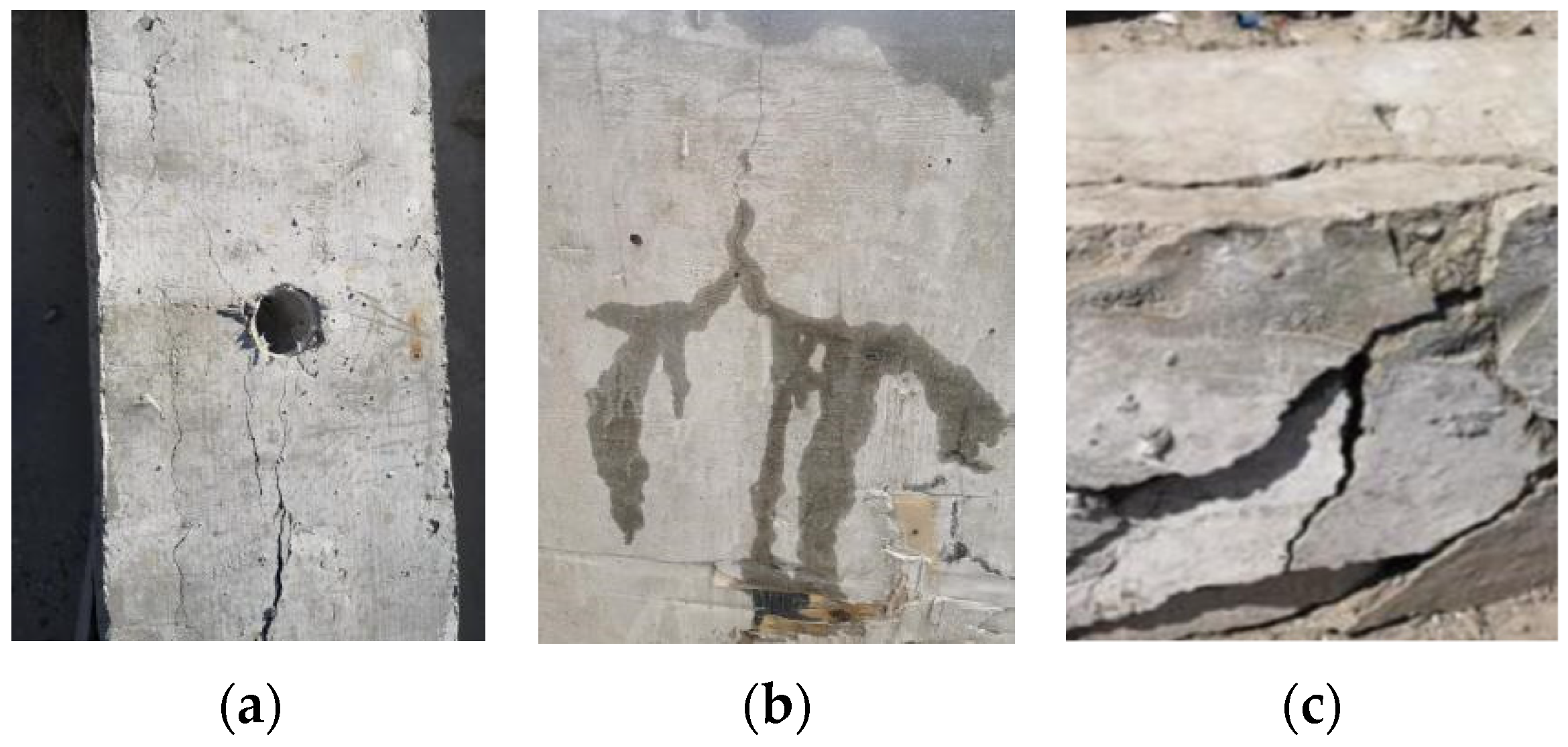
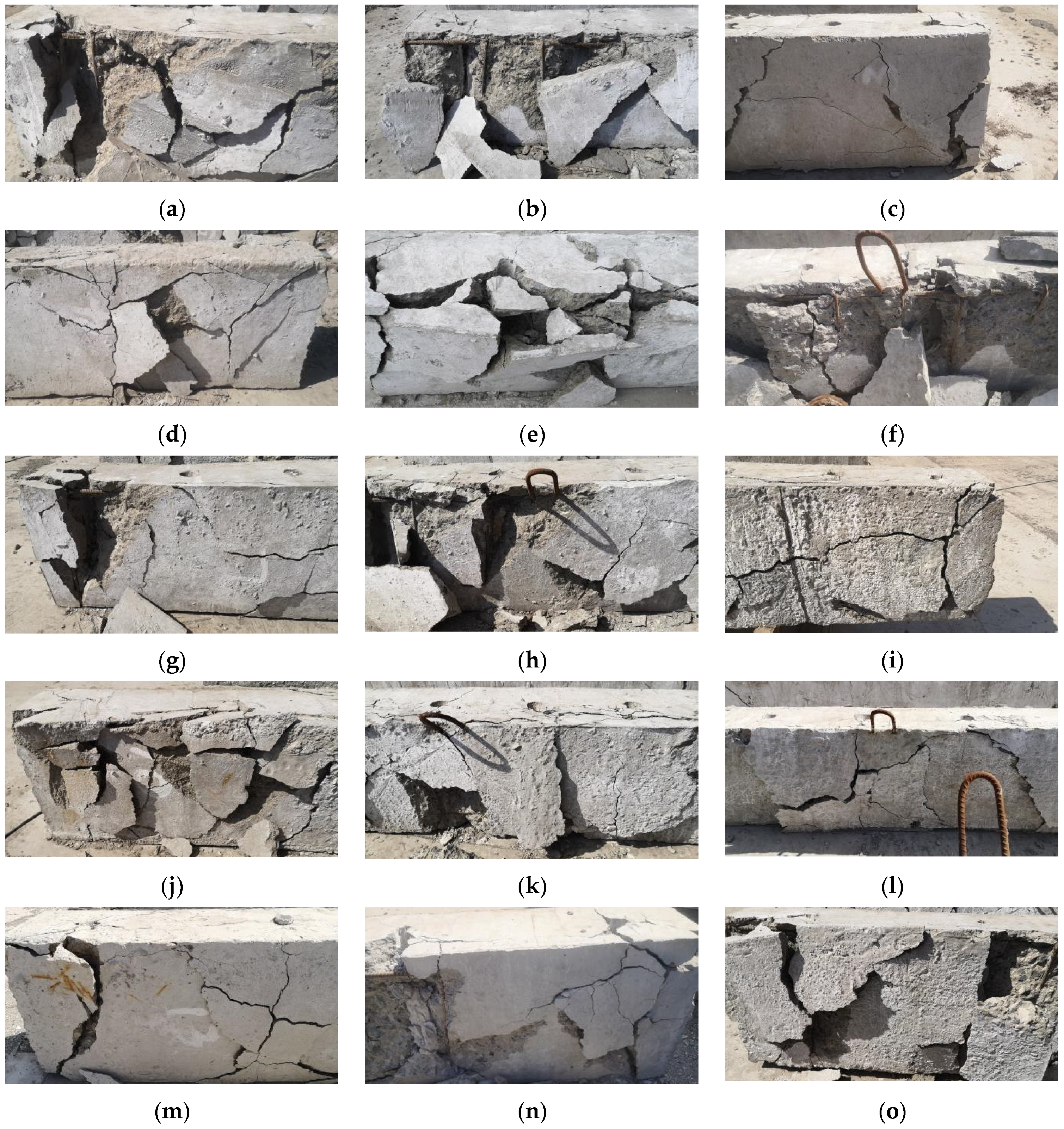





| Compressive Strength fcu (N/mm2) | Tensile Strength fc (N/mm2) | Density ρ (g/mm3) | Modulus of Elasticity E (N/mm2) |
|---|---|---|---|
| 40.0 | 3.8 | 2.32 × 109 | 3.4 × 104 |
| Beam Label | fcu (N/mm2) | fc (N/mm2) | Aperture (mm) | Hole Spacing (mm) | End Distance (mm) | Edge Distance (mm) |
|---|---|---|---|---|---|---|
| L-1 | 34.6 | 26.1 | 40 | 300 | 150 | 125 |
| L-2 | 34.6 | 26.1 | 40 | 400 | 200 | 125 |
| L-3 | 34.6 | 26.1 | 50 | 300 | 150 | 125 |
| L-4 | 44.3 | 30.9 | 50 | 400 | 200 | 125 |
| L-5 | 25.6 | 19.5 | 40 | 300 | 150 | 125 |
| L-6 | 25.6 | 19.5 | 40 | 400 | 200 | 125 |
| L-7 | 34.6 | 26.1 | 50 | 300 | 150 | 125 |
| L-8 | 25.6 | 19.5 | 50 | 400 | 200 | 125 |
| L-9 | 44.3 | 30.9 | 40 | 300 | 150 | 125 |
| L-10 | 44.3 | 30.9 | 40 | 400 | 200 | 125 |
| L-11 | 25.6 | 19.5 | 50 | 300 | 150 | 125 |
| L-12 | 44.3 | 30.9 | 50 | 400 | 200 | 125 |
| L-13 | 25.6 | 19.5 | 40 | 500 | 200 | 125 |
| L-14 | 34.6 | 26.1 | 40 | 500 | 200 | 125 |
| L-15 | 44.3 | 30.9 | 40 | 500 | 200 | 125 |
Publisher’s Note: MDPI stays neutral with regard to jurisdictional claims in published maps and institutional affiliations. |
© 2022 by the authors. Licensee MDPI, Basel, Switzerland. This article is an open access article distributed under the terms and conditions of the Creative Commons Attribution (CC BY) license (https://creativecommons.org/licenses/by/4.0/).
Share and Cite
Wang, X.; Liu, P.; Sun, Y.; Wang, W. Study on Breaking Concrete Structures by Pulse Power Technology. Buildings 2022, 12, 274. https://doi.org/10.3390/buildings12030274
Wang X, Liu P, Sun Y, Wang W. Study on Breaking Concrete Structures by Pulse Power Technology. Buildings. 2022; 12(3):274. https://doi.org/10.3390/buildings12030274
Chicago/Turabian StyleWang, Xiaodong, Pingjian Liu, Yixuan Sun, and Wenqi Wang. 2022. "Study on Breaking Concrete Structures by Pulse Power Technology" Buildings 12, no. 3: 274. https://doi.org/10.3390/buildings12030274
APA StyleWang, X., Liu, P., Sun, Y., & Wang, W. (2022). Study on Breaking Concrete Structures by Pulse Power Technology. Buildings, 12(3), 274. https://doi.org/10.3390/buildings12030274






